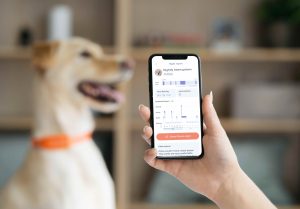How to Tell if Your Dog Has A Fever & How to Prevent It

Written by Maven Pet for Odie Pet Insurance
Fevers occur when a dog’s body temperature rises above normal, and depending on the cause and severity, they can impact their overall health. Learn how to spot the common symptoms of dog fever, when it’s time to worry, and what you can do at home. Tools like the pet health app from Maven Pet can help you track early changes before a fever becomes serious.
How Do You Know If Your Dog Has a Fever?
First things first – indeed, how can you tell if your dog has a fever? The most obvious tell will be a change in their usual behavior.
The most common dog fever symptoms include:
- red eyes;
- lethargy (a sudden decrease in activity);
- loss of appetite;
- shivering;
- warm ears and/or a warm nose;
- vomiting.
If your dog has any combination of those symptoms, the next step is to check their temperature in order to properly assess the situation. You can use a digital or rectal thermometer to do so.
You may have heard that it’s possible to check if a dog has a fever by touching their head… But long story short, that’s a myth. Dog fevers can already be difficult to identify using the proper means! Their temperature is naturally higher than a human’s, so it would be really hard to accurately gauge whether they have a fever just by touch (head or otherwise).
In dogs, the normal temperature range is usually between 101° to 102.5° Fahrenheit. They are more prone to overheating than people, too. If your dog’s temperature is over 103° Fahrenheit, they have a fever – and if it reaches 106° Fahrenheit, they may suffer serious or even fatal complications. That’s why thermometer readings are the only safe way to determine if your dog has a fever.
Can Dogs Recover from Fever on Their Own?
This will depend on the type of fever the dog has. Mild fevers can sometimes resolve naturally, while persistent fevers (or those accompanied by severe symptoms) may indicate a serious underlying condition. In those cases, professional care should be sought right away! As previously mentioned, if the dog’s temperature is over 106° Fahrenheit, you should immediately take them to your local veterinary clinic.
With the dog health tracker from Maven Pet, pet parents can catch early signs of fevers and other developing conditions in their early stages. It monitors each pet’s activity and rest in detail, along with other health indicators. If there’s an unusual variation regarding their usual patterns or other potential changes that may mean problems, you’ll be immediately notified. That way, you can get ahead of pet health issues and guarantee the best outcomes for your furry friend!
Dog Fever Treatment at Home
Let’s say you’ve established that your dog has a fever and it is not serious enough for a visit to the vet clinic. Here are a couple of things you can do for a dog fever treatment at home:
- Make sure they have plenty of fresh water to drink so they stay hydrated; you can try to coax them into drinking small amounts, but don’t force them!
- Create a cool resting environment for them to recover. You may try to help them cope by using a soaked cloth to apply cool water to their ears and paws.
- Allow them to rest so they can recover their energy (avoid long walks or playtime).
Continue to monitor their condition to see if the fever improves or if a visit to the clinic should be considered. Do not give your dog human medication (like ibuprofen or acetaminophen, for example). Most of those are toxic to dogs and will have negative effects instead of improving their condition. Remember to always ask your vet before administering any medication to your pets!
Preventing Fevers in Dogs
Prevention is still the best medicine. There are some actions you can take to help your dog avoid getting a fever, or at least to make sure they’re well equipped to deal with one.
The easiest measure is to maintain a clean environment. Keeping their living area properly clean and well-ventilated will help to minimize the risk of infection and thus to prevent your dog from getting sick. Their toys, bedding, and bowls should also be regularly washed.
Keeping your dog up-to-date on vaccinations is another important measure – follow your vet’s recommendations on this topic.
Finally, be mindful of dietary risks. Avoid sudden diet changes, and limit access to fatty foods.
Tools like the Maven Pet health tracker help you keep an eye on your best friend’s health, so you can act at the first sign of trouble. Maven goes as far as automatically tracks respiratory rate and heart rate, water intake (in dogs), itch behaviors, rest, and activity, offering real-time alerts so nothing slips by unnoticed.
Conclusion
The easiest way to determine if your canine companion has a fever is to analyze their behavior. Common dog fever symptoms will affect their disposition – if they’re showing several of those signs, try to assess their temperature to determine the next steps.
Concerning a possible dog fever treatment at home, while there are some things you could do, remember that it all depends on how serious the fever is. If you’re in doubt, the best course of action is to take your pup to the vet.
Your dog’s health should be taken seriously, but keeping up with it doesn’t have to be hard. As technology advances, tools like the pet health tracker from Maven Pet can help you stay ahead of developing issues without having to worry about whether you’re missing any signs of problems.
To ensure your pet has the best coverage and you’re prepared for any unexpected health issues that may arise, have a look at Odie Pet Insurance’s plans.




